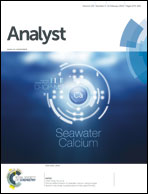Probing for DNA methylation with a voltammetric DNA detector
Abstract
A label-free electrochemical detection of DNA hybridization is used for probing synthetic methylated ssDNA 27-mer or 33-mer targets from the GSTP1-gene. The method is based on electrostatic modulation of the anion-exchange kinetics of a polypyrrole bilayer film deposited on platinum-microelectrodes to which a synthetic single-stranded 15-mer GSTP-1 promoter probe DNA has been attached (DNA detector). The effect of the contact of this DNA-detector with non-methylated and methylated complementary DNA sequences in Tris-buffer is compared using cyclic voltammetry (CV). The DNA-hybridization taking place at the electrode surface leads to a significant decrease of the CV area recorded after exposure to complementary target DNA in comparison to the CV change recorded for non-complementary DNA target. The performance of this miniaturized DNA detector was optimized with respect to hybridization time, temperature, and concentration of the target. It was also evaluated with respect to selectivity, sensitivity, and reproducibility. These results are significant for their possible use as a screening test for hypermethylated DNA sequences.


 Please wait while we load your content...
Please wait while we load your content...